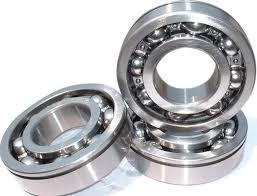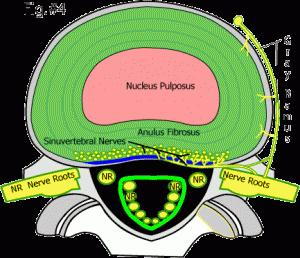
 Spinal disc, they can degenerate, tear, bulge or even herniate, but they do not slip! Although when most use the terminology of slipped disc they are describing one of the above terms.
Spinal disc, they can degenerate, tear, bulge or even herniate, but they do not slip! Although when most use the terminology of slipped disc they are describing one of the above terms.
This of your spinal disc as the ball bearings of your spine. They separate each vertebrae and create necessary spacing for our nerves to exit the our spinal cord and connect to all our vital tissues to our brain. They act as a cushioning to force between your spinal segments. The disc has two main components first a layer of rings of fibrous tissue called the anulus fibrosis. The second component is a soft jelly like center called the nucleus pulposus. The tough layer of fibrous rings keeps the jelly like center in tact.

In our practice, we see two common disc problems:
Bulging Disc
A weakened area of the anulus, often caused by repetive stress can cause tearing in the rings of the anulus fibrosis, (outer layer) can allow the softer nucleus of the disc to bulge like a balloon. This can put pressure on nearby nerves, leaving pain and often times symptoms traveling into the buttocks and legs called sciatica. Bulging discs cases respond well. With improved spinal function we’ve seen many cases resolve nicely.
Herniated Disc
A herniated or ruptured disc is more serious. It can occur anywhere in the spine, but is most common in the lower back. This is when tears in the anulus rings allow for the central jelly like material to push out into the spinal canal. This is usually through a weakened area due to trauma or degeneration.
How we can help
Treating a disc can be rather tricky because of several factors. The first is disc injuries tend to be tremendously painful and a conservative approach in the beginning of treatment is recommended. Because the disc, whether bulging or herniated is being pressed out towards the spinal canal it is essential to create a force that facilitates the retraction of the jelly like center of the disc back to where it belongs. To do this we try to create a negative pressure of a vacuum force within the disc. This can be achieved with either flexion-distraction traction or decompression. Another tricky factor in treating disc injuries is that disc do not have direct blood flow. Blood flow is essential to proper healing. For a disc to achieve proper nutrients from our blood a pumping action that is created in decompression or flexion-distraction allows blood permeate into the disc through a process called imbibition.
Important considerations
Disc injuries are more likely to occur or be recurrent due to poor spinal bio mechanics and weak core musculature. Chiropractic as well as proper core strengthening program (check here for some good core exercises most can benefit from). are essential in making sure that a disc bulge does not become a disc herniation or more importantly once you have had a herniation it doesn’t happen again. Recurring disc injuries often eventually lead to surgery.
